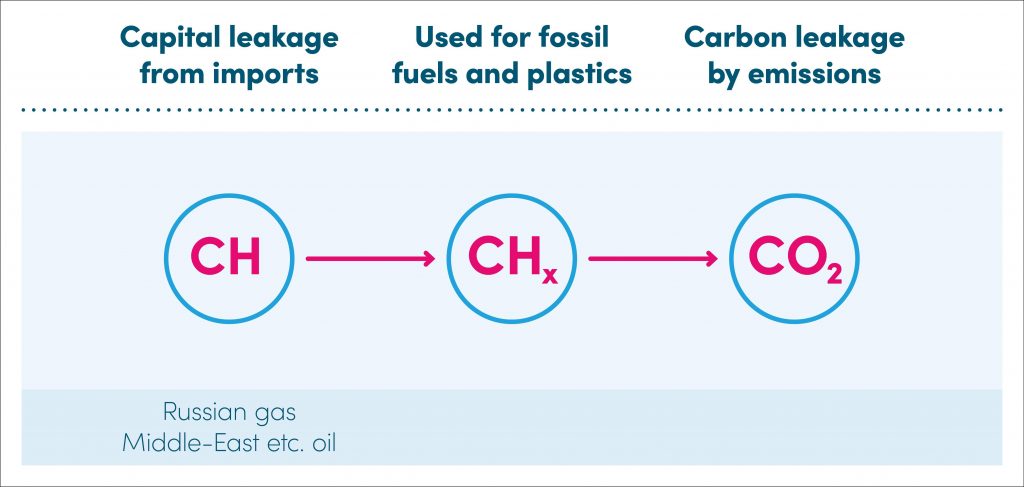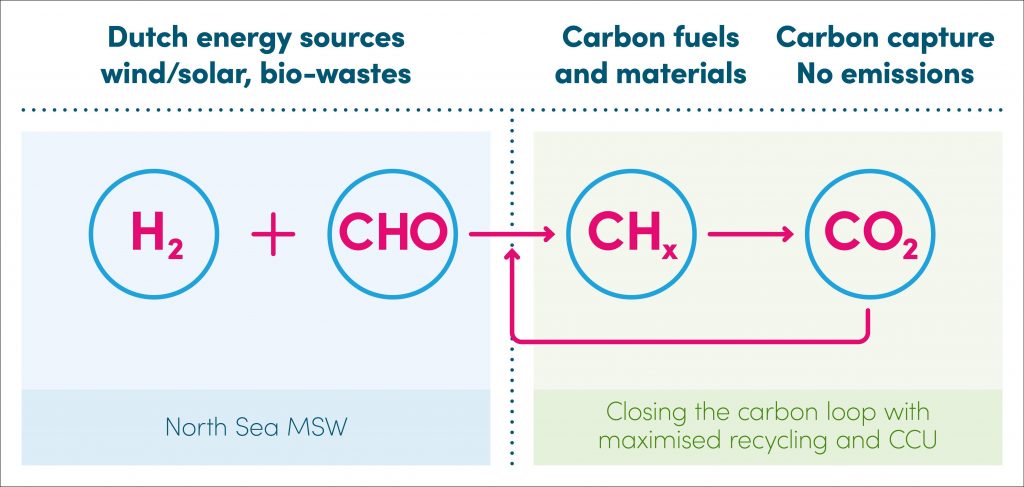Today the Dutch economy faces a challenge from fossil hydro-carbons. On one hand related to capital leakage by fossil resource imports as these are currently a main source for our energy, plastics and a large variety of other products. On the other hand, when burned as a fuel or for energy production, these fossils are the main cause for CO2 emissions contributing to global warming.


With PACT 2030® we believe that the solution to the energy transition is still hydro-carbon based, since hydro-carbon molecules are a great energy container, and because they form an excellent building block for products like plastics. Nevertheless, we think the source of these hydro-carbons should be a combination of Hydrogen molecules from wind and solar energy plus some bio-based but most recycled carbons, including recycled CO2. Maximised from Dutch origins rather than from imported fossils.
Currently multiple sustainable technologies at different levels are being worked, as presented on picture below.
The left part of this picture represents “the hydrogen economy” in blue, which is directly linked to electrochemical syntheses. Hydrogen economy appears to be the ultimate clean solution, and according to some the only solution to address the Energy Transition.
However, we belief the future also a Carbon (and Bio Mass) Economy as shown in green on the picture.
For instance, Carbon is very important for materials like plastics, distribution of condensed fuels, as well as biomass that consist of carbons.
Our vision for the Energy Transition is an integration of the Hydrogen and Carbon based economy, in which Carbons are fully recycled; not released to the environment in form of CO2 or (plastic) waste. We believe there are 4 levels, or cricles of defence, to avoid the carbon spillage;
Within these circles of defence carbons should be recovered in the highest condition possible, meaning not downgraded (according to the Lansink Ladder principle).
Nevertheless the amount of carbon that is released from the carbon recycle loops ultimately should be returned to the chain through CCU. Any additional Carbon supplementation should come from biomass.
If you would like to know more about our PACT2030 approach, please contact us.
| Cookie | Duur | Omschrijving |
|---|---|---|
| cookielawinfo-checkbox-advertisement | 1 year | Set by the GDPR Cookie Consent plugin, this cookie is used to record the user consent for the cookies in the "Advertisement" category . |
| cookielawinfo-checkbox-analytics | 11 months | This cookie is set by GDPR Cookie Consent plugin. The cookie is used to store the user consent for the cookies in the category "Analytics". |
| cookielawinfo-checkbox-functional | 11 months | The cookie is set by GDPR cookie consent to record the user consent for the cookies in the category "Functional". |
| cookielawinfo-checkbox-necessary | 11 months | This cookie is set by GDPR Cookie Consent plugin. The cookies is used to store the user consent for the cookies in the category "Necessary". |
| cookielawinfo-checkbox-others | 11 months | This cookie is set by GDPR Cookie Consent plugin. The cookie is used to store the user consent for the cookies in the category "Other. |
| cookielawinfo-checkbox-performance | 11 months | This cookie is set by GDPR Cookie Consent plugin. The cookie is used to store the user consent for the cookies in the category "Performance". |
| elementor | never | This cookie is used by the website's WordPress theme. It allows the website owner to implement or change the website's content in real-time. |
| viewed_cookie_policy | 11 months | The cookie is set by the GDPR Cookie Consent plugin and is used to store whether or not user has consented to the use of cookies. It does not store any personal data. |
| Cookie | Duur | Omschrijving |
|---|---|---|
| _ga | 2 years | The _ga cookie, installed by Google Analytics, calculates visitor, session and campaign data and also keeps track of site usage for the site's analytics report. The cookie stores information anonymously and assigns a randomly generated number to recognize unique visitors. |
| _ga_X73X5YES1T | 2 years | This cookie is installed by Google Analytics. |
| _gat_gtag_UA_215890515_1 | 1 minute | Set by Google to distinguish users. |
| _gid | 1 day | Installed by Google Analytics, _gid cookie stores information on how visitors use a website, while also creating an analytics report of the website's performance. Some of the data that are collected include the number of visitors, their source, and the pages they visit anonymously. |